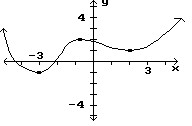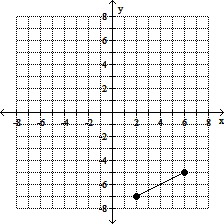Sketch a graph of a function f that has the given properties.(a) Defined for all real numbers(b) Increasing for -3 < x < -1 and 2 < x < ?(c) Decreasing for -? < x < -3 and -1 < x < 2(d) Concave upward for -? < x < -2 and 1 < x < ?(e) Concave downward for -2 < x < 1(f) f'(-3) = f'(-1) = f'(2) = 0(g) Inflection point at (-2, 0) and (1, 1)
What will be an ideal response?

You might also like to view...
The probability that a specific meteor will hit the Earth is based on: ?
A. ?Scientific evidence based on patterns of meteor velocity and trajectory. B. ?Scientific evidence based on changing trajectories of the meteor. C. ?Data collected on past encounters with the meteor. D. ?Analysis of extremely unlikely events. E. ?All of the above.
Find the distance d(P1, P2) between the points P1 and P2.
A. 2
B. 12
C. 12
D. 2
Solve. x =
x =  -
- 
A. - 
B. 
C. 
D. - 
Find the center, transverse axis, vertices, foci, and asymptotes of the hyperbola. -
-  = 1
= 1
A. center at (4, 3)
transverse axis is parallel to x-axis
vertices at (1, 3) and (7, 3)
foci at (4 -  , 3) and (4 +
, 3) and (4 +  , 3)
, 3)
asymptotes of y - 3 = -  (x - 4) and y - 3 =
(x - 4) and y - 3 =  (x - 4)
(x - 4)
B. center at (4, 3)
transverse axis is parallel to y-axis
vertices at (4, 1) and (4, 5)
foci at (4, 3 -  ) and (4, 3 +
) and (4, 3 +  )
)
asymptotes of y + 3 = -  (x + 4) and y + 3 =
(x + 4) and y + 3 =  (x + 4)
(x + 4)
C. center at (3, 4)
transverse axis is parallel to x-axis
vertices at (1, 4) and (5, 4)
foci at (3 -  , 4) and (3 +
, 4) and (3 +  , 4)
, 4)
asymptotes of y - 4 = -  (x - 3) and y - 4 =
(x - 3) and y - 4 =  (x - 3)
(x - 3)
D. center at (4, 3)
transverse axis is parallel to x-axis
vertices at (2, 3) and (6, 3)
foci at (4 -  , 3) and (4 +
, 3) and (4 +  , 3)
, 3)
asymptotes of y - 3 = -  (x - 4) and y - 3 =
(x - 4) and y - 3 =  (x - 4)
(x - 4)